The first live fantasy football draft I ever participated in was in 2003. I was 13 years old, drafting against 11 middle-aged men. The draft was scheduled for 1 p.m., but a heated debate would push the draft back several hours. After Priest Holmes was selected first overall, the individual drafting second was refusing to make his selection.
“Guys, snake-style drafts are now a thing of the past. Priest Holmes has single-handedly broken standard drafts. We need to do an auction instead.”
Intimidated by the idea of an auction draft, I voted against it, though my opponent’s arguments were sound. In standard leagues, Holmes had averaged 26.6 fantasy points per game in the previous season. The next-closest non-quarterback (Ricky Williams) averaged just 19.8 fantasy points per game. My opponent felt the dropoff in value from Holmes to the next-best player severely hurt his chances of winning the league.
Arguably one could make a similar argument in snake-style drafts this season. To me, the first two picks off the board are obvious: you should be selecting either Le’Veon Bell or David Johnson. Among all non-quarterbacks, Bell's and Johnson's 2016 seasons ranked best and second-best this past decade in PPR fantasy points per game. In auction-style drafts, you must spend about 35 percent of your budget to obtain either Bell or Johnson. Last season, each went for about 25 percent of your budget. Only two followers I spoke to (1,2) had a player in their league land both in their auction draft, and in each case the Bell/Johnson owner won the league.
In general, I think snake-style drafts are more exploitable, while auction-style drafts are more equitable and fair. Snake-style drafts are also more-predictable – typically, you know what round a player will go, or should go, and it’s easier to find value. I’m a tad less experienced with auction drafts, struggling to determine the best strategy, so I wanted to take the time here today to review a recent auction draft and consider some of the strategies used.
This was a 12-team PPR auction with a $200 budget. Lineups were: 1QB, 2RBs, 3WRs, 1TE, 1Flex, and 1 Defense.
Most top-heavy team
Our top-heaviest team was Team 6, who spent 67.5 percent of their budget on just two players: Bell and Julio Jones. Here’s how it turned out:
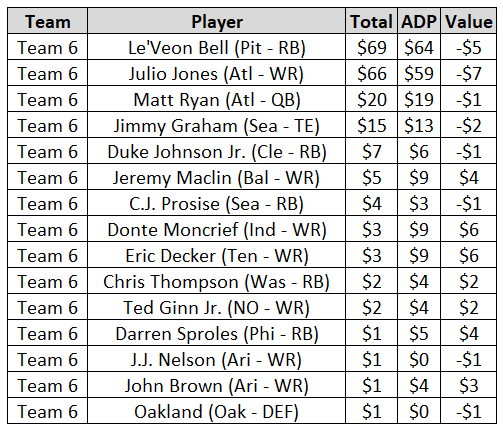
This was easily one of my least favorite teams in the entire draft. This owner has a glaring hole at RB2, likely starting one of either Duke Johnson, C.J. Prosise, Chris Thompson, or Darren Sproles each week. All are their team’s primary passing-down running back, but lack any semblance of ceiling due to limited work as a runner. They will also be forced to find three starters out of Jeremy Maclin, Donte Moncrief, Eric Decker, Ted Ginn, J.J. Nelson, or John Brown. Needless to say, spending up for two elite options had crushed their depth everywhere else. In my estimation, this team is a longshot to make the playoffs.
Most balanced team
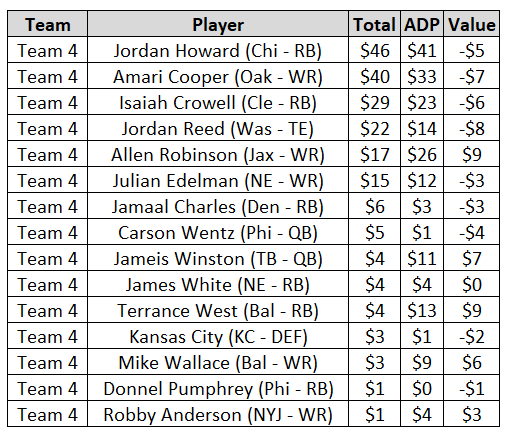
Team 4 spent a combined $115 on their top-three players, which was less than any other team in the league. They likely overspent on Carson Wentz, but got a steal in Jameis Winston (the should-be starter) at only $4. Much like in snake drafts, I’m always fearful to over-invest in the quarterback position. Team 4 overspent on Jordan Reed, but I’d likely due the same as his current ADP makes little sense to me, as I wrote about here. He appears safe at running back with Jordan Howard and Isaiah Crowell manning the starting spots, with a strong corps of backups in Jamaal Charles, James White, and potentially, the steal of the draft in Terrance West at only $4. His starting wide receivers look strong as well in Amari Cooper, Allen Robinson, and Julian Edelman, with Mike Wallace on the bench or in the flex. (Editor’s note: The draft, and this writeup, were obviously both completed before the weekend, so this is no longer true for Edelman, but the value concept holds.) This was one of my favorite teams in the draft.
Value winner
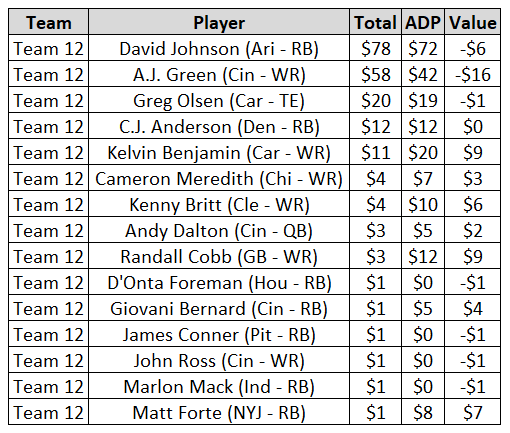
By auction ADP vs. total dollars spent, no team got a better bang for their buck than Team 12, saving $13 versus what ADP had predicted. Team 12 overspent on David Johnson and A.J. Green – two guys I’m especially high on, and saved big on Randall Cobb, Kelvin Benjamin, Kenny Britt, Matt Forte, and Cameron Meredith. (Editor's note: Here too.) As you can read about here, I’m especially high on Cobb, Britt, and Meredith this season as ADP values. This draft confirms it – for whatever reason – these players are being unnecessarily slept on. Olsen is one of my favorite tight ends this season and will be Team 12’s starter. Andy Dalton, meanwhile, worries me as his lone quarterback, but there are still several attractive upside quarterbacks in this league’s free agency pool. Team 12 paired Anderson with Johnson as his starting running back, another player I’ve been high on all offseason. On the back of a strong receiving corps (Green, Benjamin, Meredith, Britt, and Cobb), Team 12 is another one of my favorites to win the league.
Value loser
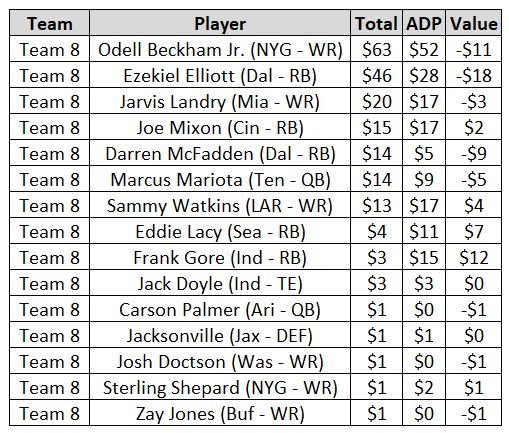
No team overspent more to grab his players than Team 8, but I don’t actually dislike their team as much as I’d expect. Though he overspent to grab both Ezekiel Elliott and Darren McFadden, I like the idea, and you might be luckier in your own draft. By ADP you could spend only $33 grab both players, which seems like a ridiculous value. $33, by ADP, equates to the ninth-most-expensive running back in auction leagues (Todd Gurley), but by my estimation, pairing both should give you top-three-level production at the position. Jack Doyle feels a little risky as the lone tight end, though I like him quite a bit. Team 8 also did a good job of pairing upside with a safe and reliable high floor at the RB2 position, mixing and matching between Joe Mixon, Frank Gore, and Eddie Lacy on a week-to-week-basis. I like his starting quarterback in Marcus Mariota, especially following the team’s overhaul at the wide receiver position. Team 8 also has a solid receiving corps in Odell Beckham Jr., Jarvis Landry, and Sammy Watkins. It’ll be tough for this team to decide who to start each week in the flex, between his backup running backs and one of Josh Doctson, Sterling Shepard, and Zay Jones. Still, despite over-paying as a whole, I like this team quite a bit.
Final observation
I noticed some surprising values towards the tail-end of the auction. Larry Fitzgerald went for just $11, and Jamison Crowder went for just $9. Kareem Hunt went for more ($11) than Spencer Ware ($7), though ADP has Ware ahead by a significant amount. (Editor’s note: This too. Amazing how he wrote up all three injured guys.) Same for Thomas Rawls ($5) and Eddie Lacy ($4). The trend I noticed here was that the later a player was nominated in the auction, the cheaper an owner had to pay for them. Perhaps this lends merit to the strategy of saving some of your money for “the players you can’t leave a draft without” and saving their nominations toward the end of your draft, when many of your opponents have little left in their budget.
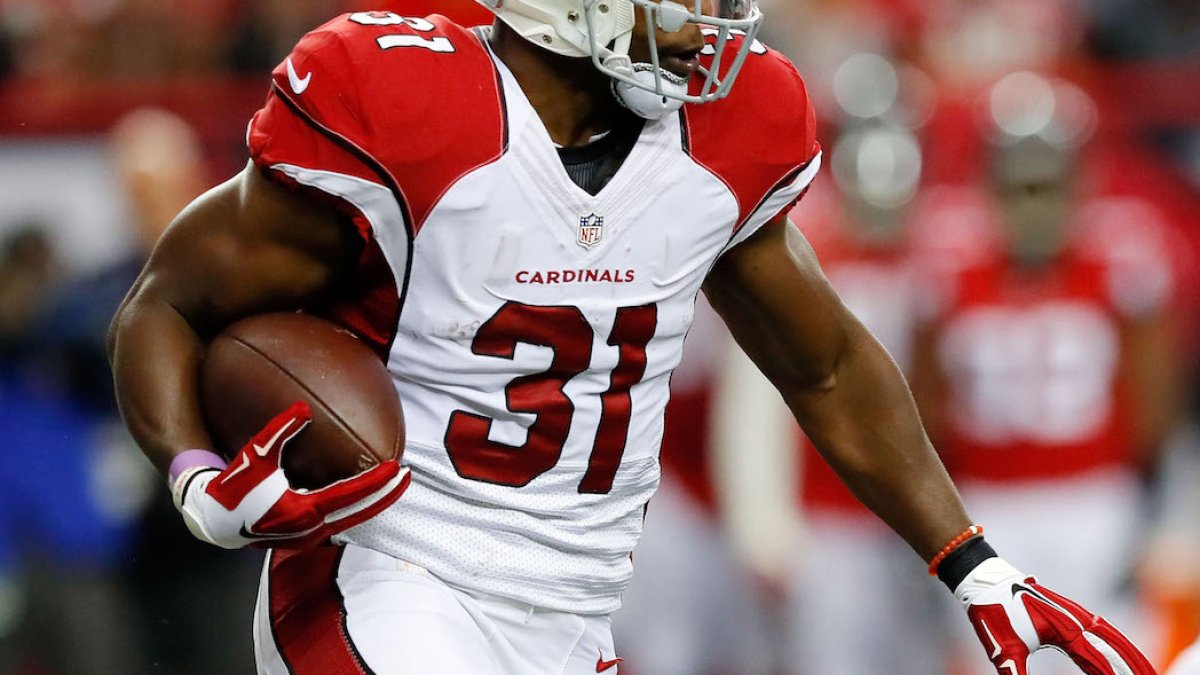


 © 2025 PFF - all rights reserved.
© 2025 PFF - all rights reserved.